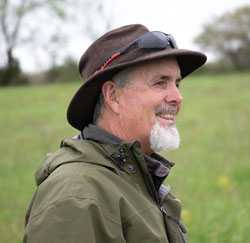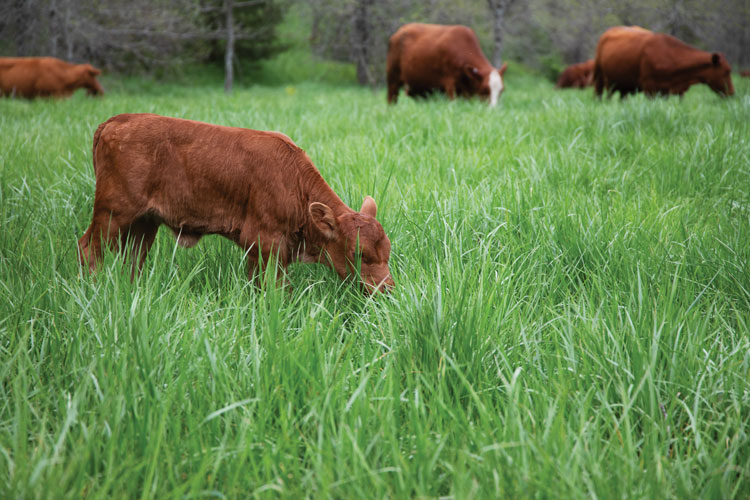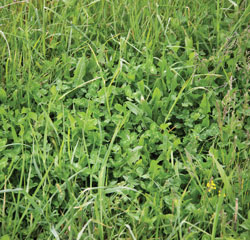
The South Poll cows were red and slick. At their side — an equal number of 1-month-old or younger calves already grazing on spring fescue in a Savannah-like setting. Their owners and caretakers, Steve and Judy Freeman, both admired and surveyed the herd while perched on their respective utility vehicles. Had the late Grant Wood been there, he would have broken out his paint brushes for an updated American Gothic.
Steve and Judy Freeman were city kids by any definition. The former was raised in Long Beach, Calif., while the latter grew up in Los Angeles. Each had some animal lovers in their ancestral bloodlines, and both matured with a desire to be around animals. So, how did two free-spirited West Coast youngsters end up in Hartville, Mo., owning and operating one of the most highly regarded grazing operations in the United States? Read on.
The couple met in San Diego, where Judy was the manager of a thoroughbred racehorse ranch and Steve was an employee. “I considered a good date as going to the bookstore,” Steve said. “It was there that we started reading about — and became interested in — homesteading.”
Soon after, with no planned destination and some saved dollars, they left California in a 1-ton van with two 80-pound dogs as passengers. They meandered around the country for close to a year, living in the van. At one point, a friend told them about the Ozark Mountains, and it sounded like an area that would meet their minimalist needs. Eventually, that’s where they headed and arrived in the area’s rolling hills in 1978. They were married during that same year.

“We knew Judy could always get a job with horses, and her employer would have to hire me because I was a part of the package,” Steve chuckled. “We ended up in Springfield, Mo., where Judy was hired at a purebred Arabian ranch while we remained living in our van.”
Eventually, the Freemans bought a small 86-acre property near where they reside and farm today, about 50 miles east of Springfield. They started a Grade C goat dairy where Judy milked 30 goats by hand and trained border collies while her husband worked on a neighboring beef farm.
Steve explained, “We were good with numbers and knew we could make it work. Our plan was to pay it off in a year. Then, about six months in, our milk processor put a quota on us and cut our price in half. That’s when we started raising some calves to supplement our income.”
While working on a beef farm and catching cattle for people with dogs that they had trained, Steve got really interested in grass and farming. “My employer was a great mentor who taught me a lot,” he said.
Steve also took a part-time job as a milk tester, thinking that he could learn about dairying, which might provide the couple’s ticket to independence. What he determined was that if there was a way — other than dairying — to make a living by farming, they should pursue it. “The early 1980s was not a time that inspired you to want to get into dairy farming,” he said.
Although the farm economy was in shambles, the young couple had saved money from an inheritance and figured it was a good time to buy a farm because land values had crashed. That was the beginning of their foray into the beef business. They sold their 86 acres in 1987 and bought the 468-acre farm they now own and operate, expanding it to 900 grazeable acres. “That first year, we bought cow-calf pairs in March — the bottom of the market — and sold steers early the next year for what we paid for the pair,” Judy recalled. “Our timing was just blind luck,” Steve added.
The Freemans currently have 180 brood cows, breed 60 to 80 home-raised yearling heifers, and also purchase stockers to graze with the heifers. “If we have a drought year, we don’t want to be put in a position of selling our breeding stock,” Steve said. “So, we like to keep a cushion and protect ourselves. However, we also want to utilize our grass during the good times. That’s where the stockers come into play, and it’s worked really well. We can sell those stockers in a week if we have to,” he added.
Trials and errors
Steve noted that there’s been a lot of experimentation to match the right number of animals to acres. “When you’re dealing with biology, that sweet spot is a moving target. But you’ve got to learn how to keep the canoe afloat and not drown in those dry years. Right now, we’re at about 3 animal units per grazeable acre. We’ve been under 2 animal units per acre, but that required feeding a lot more hay.”
The Freemans stopped making their own hay about 20 years ago and now purchase what they need. “When we sold the baler, that was liberation day for me,” Steve said, noting that he was making his own hay plus doing custom baling for neighbors.
“Haymaking took a lot of time away from our cows and grass. The cows have to be the number one priority when you’re in this business, and making hay just kept me from things I needed to be doing,” Steve said. “Admittedly, there have been dry years when we’ve had to pull the cattle off pasture and feed purchased hay in a sacrifice pasture. Afterward, we just renovate the pasture once conditions improve.”

Toxicity mitigation
“All of our fescue is toxic,” Steve said. “We calve from mid-April through May, trying to match our cows’ nutritional needs and availability to the grass. Judy moves the cows — usually that means every day, but it could also be up to every three days. We try to take at least a third of the plant off each spring on all of our pastures to reduce seedhead formation.”
If needed, Steve will also clip pastures high to control seedhead development and promote tillering. That said, he no longer worries if some of their pastures get too tall. They’ve learned how to still use those pastures and also enjoy the wildlife benefits that taller pastures can offer. The Freemans don’t fertilize their pastures. “We feel like we get enough nitrogen cycling from manure and mineralization to keep pastures productive,” Steve said.
Through years of trial and error, the Freemans now have their 88 pastures fenced in rectangles or squares and use polywire and step-in posts to portion available forage to the cattle within the paddocks. “Flexibility is essential in this business,” Steve asserted, “and even those who don’t start that way eventually get to that point. We have about 120 watering points and strip-graze in the winter.”
Over time, their pastures have become more diverse, and their cattle often tend to graze the nonfescue species first. “We actually see more fescue toxicity effects in the fall when the pastures revert to a higher percentage of tall fescue,” Judy said.

Cattle are grazed the entire year, but the Freemans use bale grazing on stockpiled fescue to slow movement during the winter. Clover is also frost seeded into pastures. “I love to sow seed,” Steve said. “I’ll sow ryegrass where the pastures get damaged, and I’ve also seeded some chicory. I’ve been trying to grow warm-season grasses. That’s still a work in progress. We’ve had some failures and successes, but I still want to get more established,” he added.
Settled on South Polls
The long road of experimentation with grass has also extended to the cows. Through the years, there have been periods of Angus and Beefmaster, but the Freemans finally settled on South Polls.
“Before we switched, our cows probably weighed 1,300 to 1,600 pounds,” Steve said. “Calving ease became a real problem, especially for the first-calf heifers.”
It was Judy who suggested they do something different, so they bought some South Poll bulls to breed their heifers.
“Those bulls were small and gentle and didn’t seem to be affected by the heat like the Angus were,” Judy said. Steve added, “They were nonstop breeders, gained weight, and I swear, had a smile on their faces during the whole breeding season. It was amazing.”
The Freemans really liked the South Poll-Beefmaster cross and soon started keeping the calves after initially selling them. “Since then, we’ve been exclusively South Poll,” Judy said. “The South Polls really do well in our Missouri heat and have excellent reproductive performance. That’s important because we are breeding in July and August.”
Steve said that they keep all of the heifers and sell an equal number of cows to interested buyers, mostly for breeding stock. They also keep a few bulls to use and sell. Animals that don’t breed on time, or don’t perform well in their system, are freely culled.
“In the beef cattle business, you’ve got to be pretty bare bones. You have to increase your margins, and you’ve got to increase your turnover,” Steve said. “All of this hinges on how you manage your grass and your ability to keep the cows’ nutrition and intake needs in sync with grass growth.”
It’s been over 40 years since the Freemans left the West Coast shimmering in the rearview mirror of their 1-ton van. The journey since has been fraught with numerous trials and errors. These days, there are still challenges, but also a much higher level of contentment as the Freemans are more easily able to enjoy the cows, the grass, the plant diversity, and wildlife that all permeate their highly regarded beef operation.
This article appeared in the April-May 2023 issue of Hay & Forage Grower on pages 22-24.
Not a subscriber? Click to get the print magazine.

